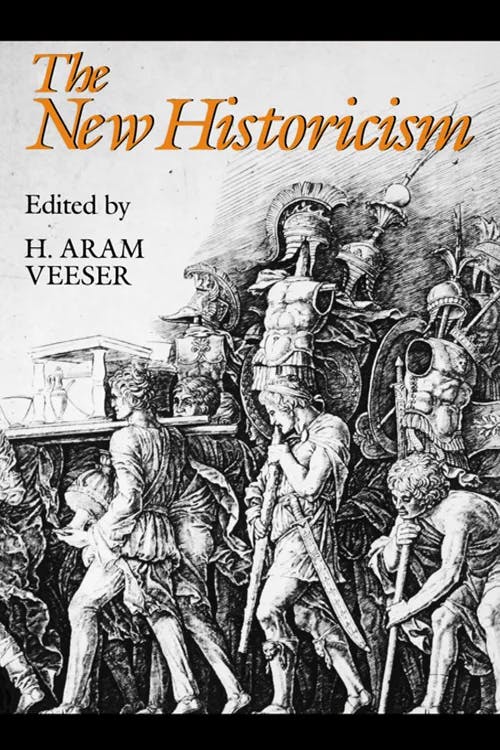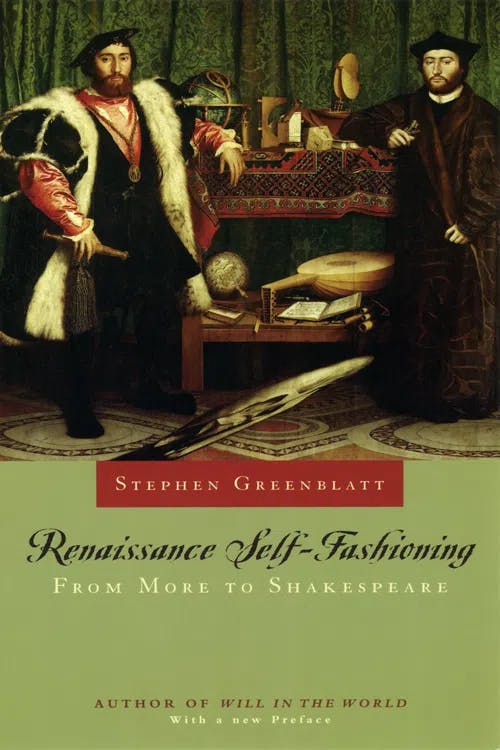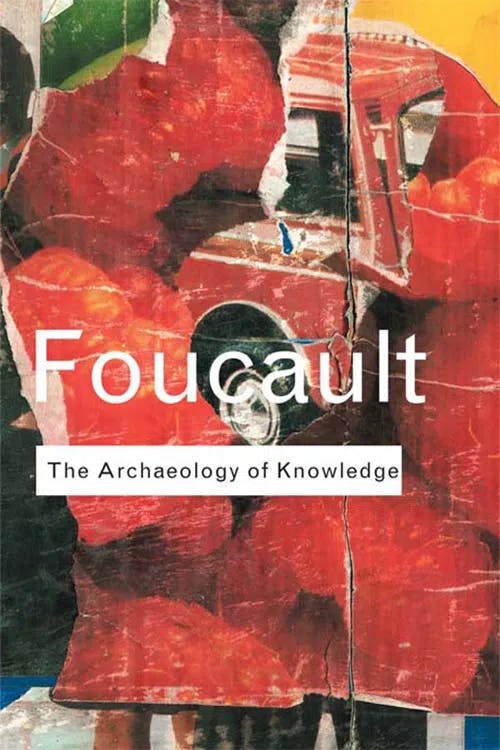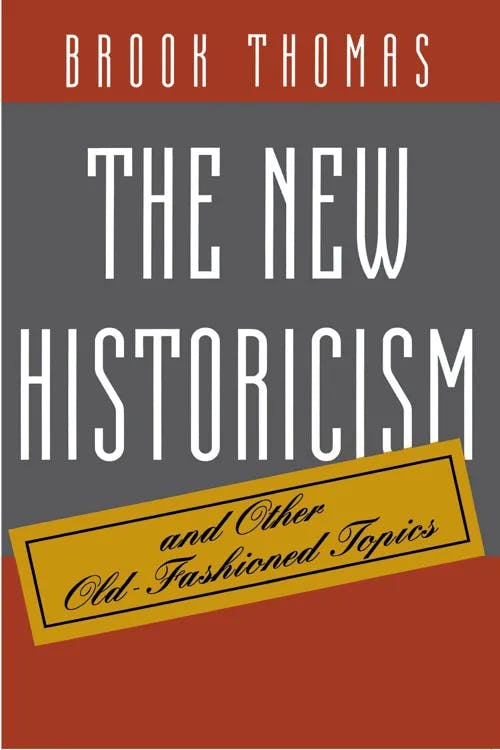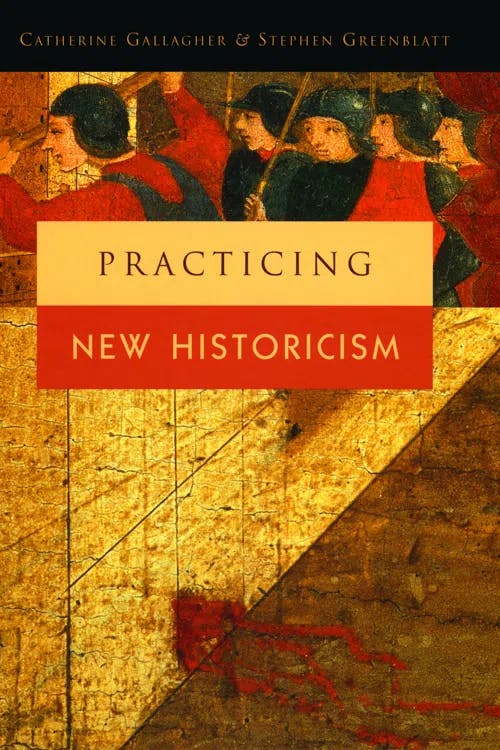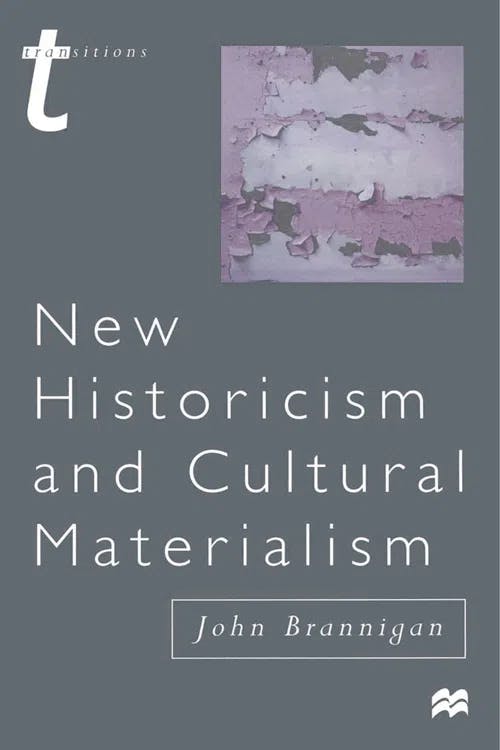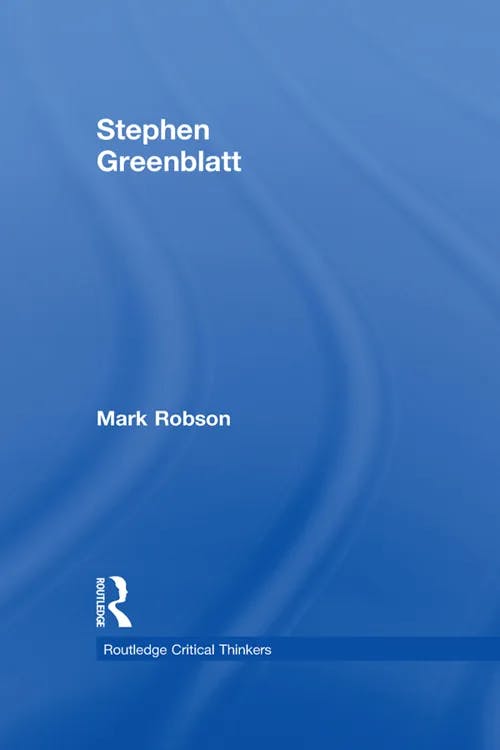What is New Historicism?
PhD, English Literature (Lancaster University)
Date Published: 10.05.2023,
Last Updated: 01.02.2024
Share this article
Definition and origin
Can we ever truly separate the art from the artist? Can we appreciate or interpret a work of art without examining the context in which it was produced? For new historicists, the simple answer is “no”. New historicism is a literary theory that argues that literature should be understood and interpreted within its historical and cultural context; this involves examining both the context of production and the context of reception.
In his work The Power of Forms in the English Renaissance (1982), Stephen Greenblatt coined the term “new historicism” to describe this way of examining literature, basing his theory, partly, on the work of Michel Foucault. New historicism differs from historicism by looking at the specific contexts influencing a work of literature or art. For example, a historicist may look solely at larger historical events or entire periods; conversely, a new historicist would look at the specifics of the author’s background and experiences, as well as that of the critic. New historicism sees literature as not merely being impacted by history, but as something that can influence and be influenced by history, seeing their relationship as being reciprocal. History, as viewed by new historicism, is not objective as it is discursively produced. History should, therefore, be used to help us understand how historical viewpoints are complex and filtered through our own experiences. New historicists, therefore, recognize their own subjectivities and biases and feel obligated to disclose their own political and philosophical views. This disclosure is known as self-positioning.
In The New Historicism (2013), Harold Aram Veeser explains that,
A newcomer to New Historicism might feel reassured that, for all its heterogeneity, key assumptions continually reappear and bind together the avowed practitioners and even some of their critics [...]
Harold Aram Veeser
A newcomer to New Historicism might feel reassured that, for all its heterogeneity, key assumptions continually reappear and bind together the avowed practitioners and even some of their critics [...]
The key assumptions he identifies are,
1. “Every expressive act is embedded in a network of material practices”
When authors express themselves, they are either consciously or unconsciously influenced by their own culture, material circumstances and environment. We can, therefore, see the author’s ideologies, political views, and perspective seep into their work.
2. “Every act of unmasking, critique, and opposition uses the tools it condemns and risks falling prey to the practice it exposes”
Critics also bring their own experiences, biases, and perspectives into their interpretations of a text.
3. “Literary and non-literary ‘texts’ circulate inseparably”
No texts should be separated based on their perceived literary value. New historicism, therefore, aims to combat literary elitism. It is important to acknowledge both “high” and “low” forms of literature to fully understand a period. For example, a lot of canonical literature was inspired by popular, “trash” fiction; Bram Stoker’s Dracula (1897, [2012]) was influenced in part by the penny dreadful Varney the Vampyre (1845-46, [2012]) by James Malcolm Rymer.
4. “No discourse, imaginative or archival, gives access to unchanging truths nor expresses inalterable human nature”
There is no such thing as a universal truth and, as such, there are no literary works which can expose deeper truths.
5. “A critical method and a language adequate to describe culture under capitalism participate in the economy they describe”
Though new historicists often criticize capitalism, they are participating in and upholding the capitalist economy by publishing academic books and working at wealthy universities. If a critic publishes a work on capitalism and exploitation, they contribute to the publishing company; the academic may work at a university and the fees paid by the students contribute to the salaries of those at the university in executive positions.
Stephen Greenblatt and self-fashioning
In The Power of Forms in the English Renaissance (1982), Greenblatt discusses literature in relation to “self-fashioning” in the Renaissance period. Self-fashioning is used to explain how individuals create their identity in line with societal norms and cultural expectations. For example, nobles would dress in a way which denoted their station and fashioned themselves to reflect the identity they wanted to convey, and what was expected for someone of that class.
Literature, he suggests, functions in a similar way and has three layers:
- A work reflects the attitudes, values, and ideas of its author.
- A work of literature reflects control mechanisms and social codes which shape our behavior.
- A work of literature reflects upon and comments on those mechanisms and codes.
Literature, therefore, is emblematic of the time in which it is produced, the culture’s expectations and the education and beliefs of the writer. Works of literature are informed heavily by the language of the author which can be influenced by a number of factors.
Greenblatt explains that,
Language, like other sign systems, is a collective construction; our interpretive task must be to grasp more sensitively the consequences of this fact by investigating both the social presence to the world of the literary text and the social presence of the world in the literary text. (Renaissance Self-Fashioning, 2012)
Stephen Greenblatt
Language, like other sign systems, is a collective construction; our interpretive task must be to grasp more sensitively the consequences of this fact by investigating both the social presence to the world of the literary text and the social presence of the world in the literary text. (Renaissance Self-Fashioning, 2012)
In other words, our language is shaped by everyone we have come into contact with, in addition to what we learn, read, or experience. For example, we may use slang taught to us by friends, or learn vocabulary from something we read or watch. Our language continually develops and, as such, is constructed. For literary critics, the language of a writer will be impacted by the various artworks they are exposed to, their social circle, the slang of the period, and what was culturally acceptable to talk about.
New historicism’s influences
Greenblatt’s work is indebted to Marxism, particularly the writings of Louis Althusser and Frederic Jameson. Jameson, for example, believes texts should be understood through the social and economic circumstances at the time of production; Jameson’s statement “always historize” epitomized new historicist thought (The Political Unconscious, 1981, [2013]). Greenblatt also refers to the Althusserian discussion of ideology, concluding that a text’s interpretation is impacted by the ideology of the reader and the author.
One of the major influences on new historicism is philosopher Michel Foucault. Foucault suggests that history can never be objective as concepts of truth and knowledge are shaped by hegemony and then legitimized by the dominant culture. In The Archeology of Knowledge (1969, [2013]), Foucault challenges the traditional method of studying history and the progress of civilizations. He explains that historians have focused primarily on “long periods” and “shifts and changes of political events”, often negating aspects of historical interest such as the “history of corn” or “the history of drought and irrigation” (2013). For Foucault, it is important we study history in a holistic way in order to “reveal several pasts, several forms of connexion, several hierarchies of importance, several networks of determination, several teleologies” (2013).
It is not just what we choose to study which can impact our understanding of history and the contexts in which we read literature, but the time in which we study history. Foucault argues that
historical descriptions are necessarily ordered by the present state of knowledge, they increase with every transformation and never cease, in turn, to break with themselves. (2013)
Michel Foucault
historical descriptions are necessarily ordered by the present state of knowledge, they increase with every transformation and never cease, in turn, to break with themselves. (2013)
Our understanding of history is contingent on a wide range of factors such as our environment, ideologies, and social and political norms. When the historian writes a description of a historic event, their writing will be influenced by current norms and existing knowledge. As such, perceptions of history can change over time. The same is true of how we understand literature or works of art from different time periods. For example, a critic writing on William Shakespeare’s The Merchant of Venice (1596–8) in the twenty-first century, may identify, and take issue with, the anti-Semitism present in the text. Our modern interpretation of Shakespeare’s work, therefore, is influenced by our own accepted norms and ideologies. As Foucault argues that knowledge and understanding (including stereotypes and norms) are shaped by the dominant ideology, we can see discourse and narratives surrounding Jewish people changing over time in accordance with the development of ethics, and an awareness of the ramifications of prejudice. (See our study guide for more information on Foucault and power relations.)
Brook Thomas explains that Greenblatt’s “attraction” to Foucault comes from his “distrust of marxism’s totalized worldview” (The New Historicism and Other Old-Fashioned Topics, 2021). Foucault’s work, on the contrary,
makes room for the marginalized, the bizarre, the excluded. The argument that all acts of representation produce exclusions may seem pessimistic, but the very structure of repression guarantees the existence of a marginal that resists absorption into a culture’s master narratives. (2021)
Brook Thomas
makes room for the marginalized, the bizarre, the excluded. The argument that all acts of representation produce exclusions may seem pessimistic, but the very structure of repression guarantees the existence of a marginal that resists absorption into a culture’s master narratives. (2021)
New historicism also acknowledges these marginalized groups and recognizes that grand narratives in history have resulted in the silencing of these groups. In other words, if dominant powers can control the norms and education within a culture, they are able to dictate how history is recorded, understood, and made known, leaving the stories of these groups untold. This, according to new historicism, has also resulted in a simplified view of history and a generalization of entire events, places, and eras. By taking into account a wider range of perspectives, new historicism argues we can understand a work of literature in all its complexity and nuance.
Practicing new historicism
In "Professing the Renaissance: The Poetics and Politics of Culture", Louis A. Montrose demonstrates how new historicism raises various issues for those working in Literary Studies and related fields. In recent years, he suggests, English Literature has become more open to those whose identity (in terms of race, gender, class origins etc.) “complicates their actual or imaginative participation in the cultural and ideological tradition enshrined in the works which they study and teach” (cited in The New Historicism, 2013). Montrose goes on to state that this diversification of the field can result in two possible effects: it may provoke either a “compensatory embrace of the dominant culture” or “contestatory attitudes, and provide vantage points for the appropriation and critique not only of Renaissance texts but also of the interpretive norms of Renaissance studies” (2013).
In Practicing New Historicism (2020), Catherine Gallagher and Greenblatt explain the central issues at the core of new historicism: the use of anecdotes, preoccupation with representation, fascination with the body, and skepticism towards ideology.
1. Recurrent use of anecdotes
For Gallagher and Greenblatt, anecdotes provide an alternative view of established historical records, giving a new outlook on a specific event or time period. They write that,
outlandish and irregular [anecdotes] held out the best hope for preserving the radical strangeness of the past by gathering heterogeneous elements — seemingly ephemeral details, overlooked anomalies, suppressed anachronisms — into an ensemble where ground and figure, “history” and “text” continually shifted. The desired anecdotes would not, as in the old historicism, epitomize epochal truths, but would instead undermine them. The anecdotes would open history, or place it askew, so that literary texts could find new points of insertion. (2020)
Catherine Gallagher and Stephen Greenblatt
outlandish and irregular [anecdotes] held out the best hope for preserving the radical strangeness of the past by gathering heterogeneous elements — seemingly ephemeral details, overlooked anomalies, suppressed anachronisms — into an ensemble where ground and figure, “history” and “text” continually shifted. The desired anecdotes would not, as in the old historicism, epitomize epochal truths, but would instead undermine them. The anecdotes would open history, or place it askew, so that literary texts could find new points of insertion. (2020)
Anecdotes, therefore, provide a contrast against history’s grand narratives and offer multiple viewpoints which undermine dogmatic or seemingly universal truths.
2. Preoccupation with representation
New historicists must take into account how subjective opinions, perspectives, or biases may color the way a historical event is presented by writers, historians, and artists. Gallagher and Greenblatt write,
Our project has never been about diminishing or belittling the power of artistic representation, even those with the most problematic entailments, but we never believe that our appreciation of this power necessitates either ignoring the cultural matrix out of which the representations emerge or uncritically endorsing the fantasies that the representations articulate. (2020)
In other words, new historicists need to engage with artistic representation to truly understand a culture, but must do so in a way which is critical and cognizant that such artistic renderings of the past are not to be equated with historical fact.
3. Fascination with the body
New historicism focuses on the history of the human body and the human subject, specifically in relation to life and death, or illness and health. Gallagher and Greenblatt use the example of the potato riots in the 1790s. They explain that economic historians have tended to view the riots as a response to hunger. Taking into account the wider social and cultural factors, such as the working classes’ perspective of potatoes as food for the poor, and as a symbol of their status, we can begin to see the potato riots as more complex than initially presumed. They write,
The moral economy was [...] not just a cultural mediator of responses to the physical stimulus of hunger; it was itself a physiological-cultural stimulus: both the experience of inclusion inside a corporate body and a cause of the sensation of hunger [...] Our point is not that the rejection of the potato caused the dearth of the 1790s; but the vehement refusal to accept potato substitutes for white bread when they were available points to a need for a thorough historicization of what counted as food and what felt like hunger. (2020)
Gallagher and Greenblatt make a strong case for a precise analysis of any historical event.
4. A skepticism of ideology critique
New historicism looks to gradually replace ideology critique with discourse analysis. Discourse analysis refers to studying written or spoken language in relation to the given social and cultural context.
As Gallagher and Greenblatt state,
traditional “close readings” tended to build toward an intensified sense of wondering admiration, linked to the celebration of genius, new historicist readings are more often skeptical, wary, demystifying, critical, and even adversarial. (2020)
The movement to discourse analysis arose due to many new historicists being “uncomfortable with such key concepts as super-structure and base or imputed class consciousness” (2020).
The problem with new historicism
In New Historicism and Cultural Materialism (2016), John Brannigan outlines several of the criticisms levied at new historicism.
- New historicism is not, in fact, new; literary critics have, for a long time, taken into account social and political contexts when studying a work of literature.
- Literature should “transcend” factors such as the “politics, sociology, place, and the biography, race, and sexual orientation of the author.”
- New historicism “[ignores] the universal themes of literature.”
- New historicism reduces “human agency” by attributing the “production of literature to historical forces.”
He goes on to add that,
One of the most problematic aspects of new historicism for historians, however, is its insistence on the pervasiveness and ineluctability of an overarching power, which pays scant attention as a result to the specificities and complexities of history. (Brannigan, 2016)
John Brannigan
One of the most problematic aspects of new historicism for historians, however, is its insistence on the pervasiveness and ineluctability of an overarching power, which pays scant attention as a result to the specificities and complexities of history. (Brannigan, 2016)
By making generalized statements regarding dominant powers, new historicists often do not engage with the nuances of history (in Brannigan’s view).
In “New Criticism: A Comment”, Hayden White explains why various scholarly groups, from literary critics to historians, take issue with new historicism’s framework for understanding literature. For example, progressives, White argues, can accept some fabrication, but are concerned that the ignoring of facts can result in propagandist revisions of history. If the new historicist framework acknowledges that history has no objective truth, does this justify, for example, Holocaust denialists? As White highlights, new historicism can end up excusing “specious propaganda masquerading as scholarship” (The New Historicism, 2013).
Other groups of scholars, for different reasons, reject new historicism. White writes,
by suggesting that literary texts can be illuminated by the study of their relations to their historical contexts, the New Historicists offend against the formalist tenets of an older but still powerful New Criticism. (2013)
(For more information, you can read our study guide on new criticism here.)
In addition to this, White argues that the separation of text and context is an affront to post-structuralism — which argues that “there is nothing ‘outside’ of texts” (2013).
Closing thoughts
New historicism’s belief that literature cannot be separated from the culture that produced it has provided valuable insights into Early Modern texts and beyond. When discussing the continued relevance of new historicism, Mark Robson writes,
Whether or not people call themselves new historicists [...] the influence of Greenblatt’s work seems too firmly embedded in literary studies as it is currently constituted for claims that new historicism is dead or finished with to be treated with too much seriousness. (Stephen Greenblatt, 2014)
Mark Robson
Whether or not people call themselves new historicists [...] the influence of Greenblatt’s work seems too firmly embedded in literary studies as it is currently constituted for claims that new historicism is dead or finished with to be treated with too much seriousness. (Stephen Greenblatt, 2014)
Just as history influences literature, literature can influence history. As literary works can help to establish, or resist, dominant ideology, they contribute to shaping the social milieu of a culture. This reciprocal relationship between literature and history illuminates our understanding of both fields and allows us to understand a cultural, historic moment in all its minutiae.
Further reading on Perlego
Parvini, N. (2012) Shakespeare and Contemporary Theory: New Historicism and Cultural Materialism. Bloomsbury Academic. Available at: https://www.perlego.com/book/1357576/shakespeare-and-contemporary-theory-new-historicism-and-cultural-materialism-pdf
Parvini, N. (2017) Shakespeare and New Historicist Theory. Available at: https://www.perlego.com/book/808297/shakespeare-and-new-historicist-theory-pdf
Wilson, R., and Dutton, R. (2016) New Historicism and Renaissance Drama. Available at: https://www.perlego.com/book/1568441/new-historicism-and-renaissance-drama-pdf
What is new historicism in simple terms?
What is the difference between new historicism and cultural materialism?
Who are some key new historicist thinkers?
What is an example of new historicism?
Bibliography
Brannigan, J. (2016) New Historicism and Cultural Materialism. Bloomsbury Academic. Available at: https://www.perlego.com/book/2997848/new-historicism-and-cultural-materialism-pdf
Gallagher, C. and Greenblatt, S. (eds.) (2020) Practicing New Historicism. University of Chicago Press. Available at: https://www.perlego.com/book/1852579/practicing-new-historicism-pdf
Greenblatt, S. (2012) Renaissance Self-Fashioning: From More to Shakespeare. University of Chicago Press. Available at: https://www.perlego.com/book/1851877/renaissance-selffashioning-from-more-to-shakespeare-pdf
Foucault, M. (1969, [2013]) The Archeology of Knowledge. Routledge. Available at: https://www.perlego.com/book/1612530/archaeology-of-knowledge-pdf
Jameson, F. (1981, [2013]) The Political Unconscious: Narrative as a Socially Symbolic Act. Cornell University Press. Available at: https://www.perlego.com/book/534073/the-political-unconscious-narrative-as-a-socially-symbolic-act-pdf
Morris, W. (2015)Toward a New Historicism. Princeton University Press. Available at: https://www.perlego.com/book/738423/toward-a-new-historicism-pdf
Robson, M. (2014) Stephen Greenblatt. Routledge. Available at: https://www.perlego.com/book/1619758/stephen-greenblatt-pdf
Rymer, J. M. (1845-46 [2012]) Varney the Vampyre. The Floating Press. Available at: https://www.perlego.com/book/1303457/varney-the-vampire-the-feast-of-blood-pdf
Stoker, B. (1897, [2012]) Dracula. William Collins. Available at: https://www.perlego.com/book/670643/dracula-pdf
Thomas, B. (2021)The New Historicism and Other Old-Fashioned Topics. Princeton University Press. Available at: https://www.perlego.com/book/2574868/the-new-historicism-and-other-oldfashioned-topics-pdf
Wilson, R. and R. Dutton (eds.)(2016) New Historicism and Renaissance Drama. Routledge. Available at: https://www.perlego.com/book/1568441/new-historicism-and-renaissance-drama-pdf
Veeser, H. A. (2013) The New Historicism. Routledge. Available at: https://www.perlego.com/book/1547183/the-new-historicism-pdf
PhD, English Literature (Lancaster University)
Sophie Raine has a PhD from Lancaster University. Her work focuses on penny dreadfuls and urban spaces. Her previous publications have been featured in VPFA (2019; 2022) and the Palgrave Handbook for Steam Age Gothic (2021) and her co-edited collection Penny Dreadfuls and the Gothic was released in 2023 with University of Wales Press.

